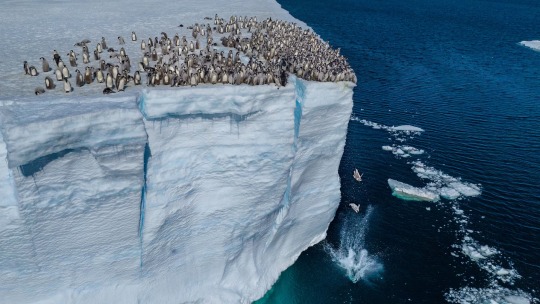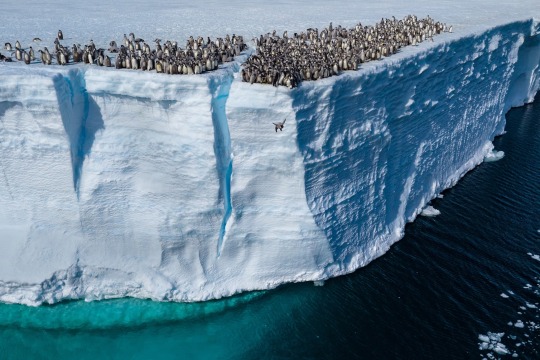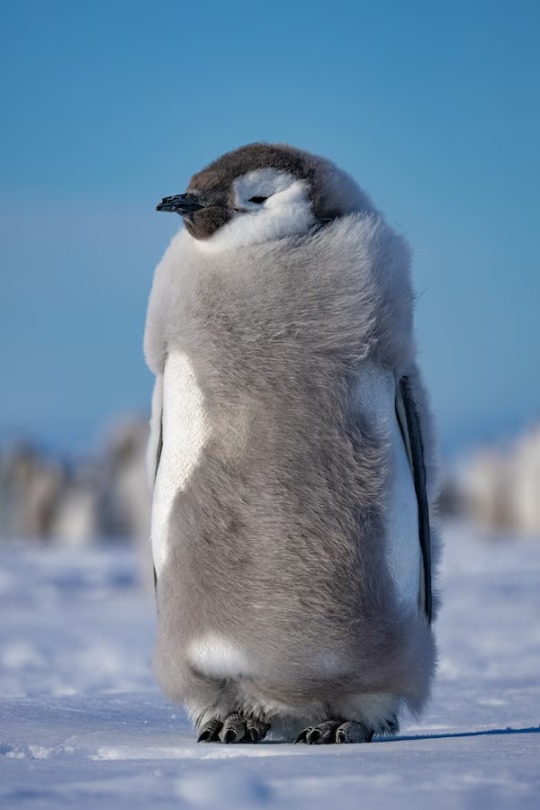#Antarctic Sea 🌊
Text
Why Are These Emperor Penguin Chicks Jumping From a 50-Foot Cliff?
The First-of-Its-Kind Footage, Taken in January 2024 Via Drone, Captures a Rare Event that May Become More Common as Sea Ice Declines and Penguins are Forced to Adapt.
— Photographs and Video By Bertie Gregory | By Rene Ebersole | April 11, 2024

Emperor penguin chicks jump off a 50-foot cliff to take their first swim in Atka Bay, Antarctica. Photographer Bertie Gregory used his drone's powerful zoom lens to maintain distance from the captivating scene.
Like a group of teenagers crowding at the top of a cliff, waiting to see if someone will be brave enough to jump into the lake first, hundreds of months-old emperor penguins gather at the top of an Antarctic ice shelf towering roughly 50 feet above the sea.
Motivated by hunger, the fledglings peer over the edge, as if considering whether they might survive a polar plunge from such a height.
Then one bird goes for it
youtube
For the first time, experts have filmed emperor penguin chicks leaping 50 feet off an Antarctic cliff. The incredible footage will appear in the series "Secrets of the Penguins," which will debut on Earth Day 2025 on National Geographic and Disney+.
Some of the onlookers crane their necks to watch it plummet and splash into the icy water below. Seconds later, the chick surfaces and swims away—off to fill its belly with fresh fish, krill, and squid. Gradually, other fledglings follow, tumbling and flapping wings built for traversing water, not air.
Filmmakers producing a documentary series called Secrets of the Penguins, which will debut on Earth Day 2025 on National Geographic and Disney+, captured the extraordinarily rare scene by drone in January in Atka Bay, on the edge of the Weddell Sea in West Antarctica. It’s the first video footage of emperor penguin chicks leaping from such a high cliff, according to scientists.

As climate change melts sea ice in Antarctica, more emperor penguin chicks are breeding on the permanent ice shelf—forcing them to jump from higher heights into the ocean.
“I cannot believe they caught it on film,” says Michelle LaRue, a conservation biologist based at the University of Canterbury in Christchurch, New Zealand. LaRue, who did not witness the jump, had visited Atka Bay to consult on the film crew’s third year of documenting emperor penguin behavior, from egg laying to chick fledging.
Ordinarily, emperor penguins nest on free-floating sea ice that thaws and blows away each year, not on the ice shelf, which is firmly attached to the land. But lately, some colonies have been nesting on the shelf. Scientists theorize that the shift could be related to increasingly earlier seasonal thawing of the sea ice caused by climate change.

At about five months old, Emperor Penguin chicks began to shed their down and grow their adult feathers, preparing for a life spent partially at sea.
The International Union for Conservation of Nature lists the world emperor penguin population, estimated to be about 500,000 birds, as near threatened due in large part to how climate change is impacting its icy realm.
In early January 2024, in the final weeks before the sea ice broke up at the end of the Southern Hemisphere summer, filmmakers spotted a group of chicks that LaRue thinks were likely raised on the ice shelf waddling north toward the cliff. Curious about where they were headed, the filmmakers dispatched a drone for a bird’s-eye view. Gradually, more chicks joined the dawdling group, growing in numbers until there were a couple hundred standing at the top of the bluff.
‘I’m Gonna Have To Go’
Gerald Kooyman, a research physiologist who has spent more than five decades studying emperor penguins in Antarctica, says he has only seen such an event once—more than 30 years ago.
“Drifting snow had formed a gently sloping ramp from the sea ice onto a grounded iceberg, and a flock of departing chicks had marched up the ramp onto the berg,” Kooyman writes in his book Journeys with Emperors, published in November 2023.
“They were stopped by a 20-meter [roughly 67-foot] cliff over a sea that was sometimes open water and other times crowded with ice floes.” Over the course of a couple days, almost 2,000 chicks assembled at the ledge.
“Finally, they started walking off the cliff,” writes Kooyman, an Emeritus Professor with the Center for Marine Biotechnology and Biomedicine at the Scripps Institution of Oceanography in California.
“Not jumping or leaping, just stepping out and falling head over heels, sometimes doing two flips before hitting the water with a resounding plop.”

Most of the fledglings survived the jump into the icy waters. The chick on the left that fell into a crevasse used its beak to climb out and leap the rest of the way.
This phenomenon is rare, say scientists who monitor penguins from satellites in space. Peter Fretwell, a British Antarctic Survey Scientist who has studied Satellite imagery of the Atka Bay emperor colony for several years, occasionally sees penguin tracks going north toward that cliff. He theorizes that the chicks in January may have followed one or two vagrant adults that “went the wrong way, basically.”
Juvenile emperors usually fledge from the sea ice, hopping just a couple feet into the ocean. But these fledglings found themselves in a tricky location for entering the water while likely feeling extremely hungry, the scientists say. Their parents had already gone to sea, sending the message that it’s time for them to fish for themselves, and the chicks had been sitting tight waiting for their sleek, waterproof adult feathers to grow in, replacing their down.
“When they get to this cliff face, they’re like, ‘Alright, I see the ocean and I need to get in there,’” LaRue says. “This does not look like a fun jump, but I guess I’m gonna have to go.”
Resilient Birds
While the scientists do not think the cliff-jumping incident was directly related to climate change warming Antarctica, Fretwell says the continuing decline of sea ice on the continent may force more emperors to breed on ice shelves, therefore making the behavior more common in the future.
Scientists have been concerned about the sudden decrease in Antarctic Sea ice since 2016 and the likely dire consequences for emperor penguins’ long-term survival.
“We estimate that we could lose the whole population by the end of the century,” Fretwell says. “It’s heartbreaking to think that the whole species may be gone if climate change continues on the path that it’s on at the moment.”
LaRue remains hopeful about the emperors’ ability to adapt, and she considers the recent high dive caught on film a testament to their hardiness.
“They’re incredibly resilient,” she says. “They have been around for millions of years; they’ve seen lots of different changes in their environment. It’s a question of how rapidly they’re able to deal with the changes that are happening—and how far they can be pushed.”
#Youtube#Penguins 🐧🐧🐧#Emperor Penguins 🐧🐧🐧#Penguin Chicks 🐣🐥#Cliff#Antarctica 🇦🇶#Antarctic Sea 🌊#Penguin Chicks Jumping#Peter Fretwell | British Antarctic Survey Scientist#Atka Bay#Satellite 🛰️📡 images#Gerald Kooyman | Research Physiologist#Emeritus Professor#Center For Marine Biotechnology & Biomedicine | Scripps | Institution of Oceanography in California.
0 notes
Text
🏚️ Exploring Earth's Harsh Habitats 🌍
Earth is a diverse and dynamic planet, boasting a wide array of ecosystems and habitats. While many of these environments are welcoming and teeming with life, there are some that challenge even the most resilient organisms. In this journey of discovery, we will explore Earth's harshest habitats and uncover the secrets of survival against all odds.
Deserts 🏜️ The arid deserts of our planet are a testament to nature's ability to adapt. From the Sahara to the Atacama, life thrives in the most unlikely places. Discover the ingenious ways desert species conserve water and beat the heat.
Polar Regions ❄️ The frozen landscapes of the Arctic and Antarctic are a harsh test for any organism. Learn how creatures like polar bears and penguins have evolved to thrive in these icy wastelands.
Volcanic Habitats 🌋 Volcanic eruptions create new land and a unique set of challenges for life to overcome. Explore the flora and fauna that call these fiery environments home.
Deep Sea Abyss 🌊 The depths of the ocean hide some of Earth's most mysterious creatures. Dive into the world of bioluminescent organisms and strange adaptations that help them survive in total darkness.
High Mountain Ecosystems ⛰️ Scaling the heights of our planet, we encounter low oxygen levels and frigid temperatures. Yet, the Himalayas and the Andes are home to remarkable wildlife and resilient plant life.
Caves and Subterranean Worlds 🦇 Venture underground to discover the eerie and captivating life forms dwelling in caves and subterranean environments, from blind fish to intricate crystal formations.
Sulfuric Springs and Acidic Lakes 🌋 Witness the vibrant colors and unique ecosystems of places where the acidity is off the charts, like Yellowstone's geysers and the acidic lakes of East Africa.
Salt Flats and Alkaline Lakes 🏞️ Explore the surreal landscapes of salt flats and alkaline lakes, where few organisms can withstand the extreme salinity.
These harsh habitats challenge life in unimaginable ways, pushing the boundaries of adaptation and resilience. Join us on this extraordinary journey as we unveil the incredible stories of survival and the astonishing beauty of Earth's harshest environments.
#ExtremeEnvironments#SurvivalOfTheFittest#HarshHabitats#NatureAdaptations#EcoWarriors#EarthExploration#ExtremeLife#UnforgivingNature#ResilientSpecies#ExtremeEcosystems#BioDiversity#ChallengingHabitats#EarthlyWonders#HabitatDiversity#AdaptOrPerish#ExtremeSurvival#EcoChallenge#Nature'sExtremes#EarthScience#LifeAgainstAllOdds
0 notes
Text
Answers🌟 Thursday Trivia Answers: Dive into a Sea of Fun Facts and Figures! 🌊🤓
You've navigated the sea of trivia, and it's time to reveal the treasure trove of answers! 🌊📚 Did you conquer the waves of knowledge? Let's find out!
🌊 Ocean Wonders:
The Mariana Trench is approximately 36,070 feet (10,994 meters) deep.
The largest living structure on Earth beneath the ocean waves is the Great Barrier Reef.
🎥 Cinematic Feats: 3. "Titanic" (1997) and "Avatar" (2009) share a connection through their director, James Cameron, who used the same prop for the sketch of Jack drawn by Rose in "Titanic" as a prop in "Avatar."
The only actor to receive an Oscar nomination for acting in a "Lord of the Rings" movie is Ian McKellen, who portrayed Gandalf.
🚀 Space Oddities: 5. The planet known as the "Red Planet" is Mars.
The first human-made object to reach space launched by the Soviet Union in 1957 was called "Sputnik 1."
🧬 Science Marvels: 7. The smallest unit of matter is an atom.
In genetics, DNA stands for "Deoxyribonucleic Acid."
🗺️ Geographical Wonders: 9. Australia is both an island and a continent.
The world's largest desert, not covered in sand, is the Antarctic Desert.
Congratulations to all the brilliant minds who dove into these trivia questions! 🎉🌐 Keep feeding your curiosity, and stay tuned for more mind-bending trivia next Thursday! 🤩 #ThursdayTrivia #TriviaAnswers #KnowledgeIsPower #CuriousMinds #DidYouKnow #BrainTeasers #FascinatingFacts #ExpandYourHorizons #LearningIsFun
0 notes
Video
The Giant Trevally's Hunting 🌊🐬🕊️🌊 #Sea #Nature #Wildlife 😎 (at The Antarctic Ocean) https://www.instagram.com/p/CfTFAggp3cP/?igshid=NGJjMDIxMWI=
0 notes
Video
youtube
🌊 Antarctic sanctuary: The Weddell Sea quest | earthrise by Al Jazeera English For centuries, mankind has been hooked on the concept of a mysterious continent at the end of the world. Ancient Greeks and Romans called it "the unknown southern land" and a century ago, Captain Robert Falcon Scott paid the ultimate price on his famous South Pole expedition. Antarctica, the planet's southernmost continent, is home to spectacular biodiversity - from emperor penguins and blue whales to krill. But climate change, plastic pollution, oil drilling and an ever-expanding commercial fishing industry are threatening this undisturbed land and its iconic creatures. Now a bid is under way to create a massive Antarctic Ocean sanctuary in the vast and remote Weddell Sea. The marine reserve would cover 1.8 million square kilometres and would be protected from direct human impacts like fishing, oil drilling and deep-sea mining. "The sanctuary will be about five times the size of Germany. The proposal is already on the table and has already got the backing of the EU," says Will McCallum, head of oceans at Greenpeace UK, who leads the Weddell Sea petition - one of the most significant campaigns in the environmental organisation's history. READ: The Weddell Sea proposal: Petition to create world's largest protected area "Scientists are saying we need to protect a third of the world's oceans, at least. If we want to let fish stocks recover, if we want to mitigate against the worst impacts of climate change, then Antarctica is a great place to start," he adds. Formulated by Germany and backed by the EU, the Weddell Sea proposal aims at creating a haven for Antarctica's wildlife and preventing the spread of the devastating effects of climate change, overfishing and pollution. Paul Ruzycki, captain of the Greenpeace icebreaker Arctic Sunrise, explains why he joined the expedition, one that could face real dangers in treacherous waters. "I am here for the same reason as the other people: for the cause ... Getting people to realise why they should care about the Antarctic ... this is wildlife that people have never come across, or will never come across," says McCallum. "Being able to tell that story relies on us getting there and relies on us getting that footage back, to talk about the importance of marine sanctuaries. Climate change will not be ... as bad if we make parts of the ocean off-limits." earthrise joins Greenpeace's expedition to the Weddell Sea, as a team of scientists, ocean photographers and ocean experts sets out to gather sufficient evidence to ensure that the proposal is carried through and that international support is garnered. - Subscribe to our channel: http://bit.ly/291RaQr - Follow us on Twitter: https://twitter.com/AJEnglish - Find us on Facebook: http://bit.ly/1iHo6G4 - Check our website: http://bit.ly/2lOp4tL #Aljazeeraenglish #News
0 notes